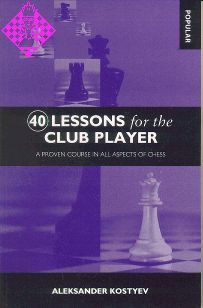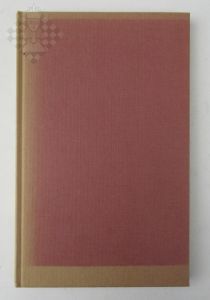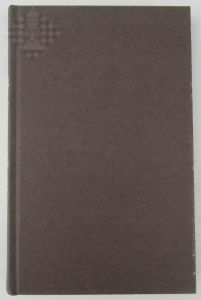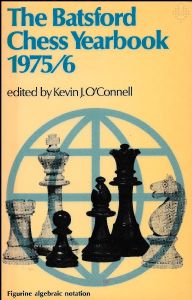Article Number
LLKOS4LCP
Author
40 Lessons for the Club Player
216 pages, paperback, Batsford Chess, 3. edition 1999, first edition 1986
Discontinued
Improve your chess with this superb teaching manual
In this follow-up to From Beginner to Expert in 40 Lessons, Aleksander Kostyev concentrates on the challenges of practical play. It is ideally suited for the club and tournament player who has reached a certain standard and wishes to improve his or her game. The material is equally suitable for the curriculum of a chess course run by a strong player or for self-instruction.
A number of complete games illustrate important opening and middlegame themes, while great attention is paid to the basic endgame positions that should be essential knowledge for anyone aspiring to "master class". The teaching methods encapsulated in this book were responsible for the enormous growth in Russian chess and for the string of top players who have dominated the world scene for many years.
This work is designed to be used by players with ratings between 140 and 180 (BCF) or 1700 - 2050 (USCF).
Aleksander Kostyev is an experienced Russian chess teacher, and was director of the Chess School of Pioneers in the former Soviet Union.
In this follow-up to From Beginner to Expert in 40 Lessons, Aleksander Kostyev concentrates on the challenges of practical play. It is ideally suited for the club and tournament player who has reached a certain standard and wishes to improve his or her game. The material is equally suitable for the curriculum of a chess course run by a strong player or for self-instruction.
A number of complete games illustrate important opening and middlegame themes, while great attention is paid to the basic endgame positions that should be essential knowledge for anyone aspiring to "master class". The teaching methods encapsulated in this book were responsible for the enormous growth in Russian chess and for the string of top players who have dominated the world scene for many years.
This work is designed to be used by players with ratings between 140 and 180 (BCF) or 1700 - 2050 (USCF).
Aleksander Kostyev is an experienced Russian chess teacher, and was director of the Chess School of Pioneers in the former Soviet Union.
| EAN | 0713452811 |
|---|---|
| Weight | 290 g |
| Manufacturer | Batsford Chess |
| Width | 13.8 cm |
| Height | 21.6 cm |
| Medium | Book |
| Year of Publication | 1999 |
| Author | Aleksander Kostyev |
| Language | English |
| Edition | 3 |
| ISBN-10 | 0713452811 |
| Year of First Edition | 1986 |
| Pages | 216 |
| Binding | paperback |
| Name | Batsford (Anova) |
|---|---|
| Adresse | 151 Freston Road London W10 6TH Großbritannien |
| Internet | www.anovabooks.com |
| rbatley@anovabooks.com |
Verantwortlicher Importeuer:
| Name | Schachversand Niggemann |
|---|---|
| Adresse | Schadowstraße 5 48163 Münster Deutschland |
| info@schachversand.de | |
| Internet | www.schachversand.de |
Contents
001 Lesson 1
Chaturanga and shatranj
When the king has not castled
Can a schoolboy win against a grandmaster?
005 Lesson 2
An assertion by shatranj theorists
The 'double mujannah'
How to prepare an attack
009 Lesson 3
The confession of Caliph al-Ma'amun
The penetration of chess to Europe
The classic bishop sacifice at h7
014 Lesson 4
When the kings have castled on the short side
022 Lesson 5
The first chess treatises
Damiano's advice - is it obsolete?
When both players have castled long
027 Lesson 6
The books by Ruy Lopez and Giulio Polerio
Storming the king's fortress
Eight concluding blows
032 Lesson 7
Kings castled on opposite sides
Pioneers on the attack
Pawn storm or piece pressure
037 Lesson 8
The early Italian School
What is meant by chess romanticism?
Basic principles of pawn endings
044 Lesson 9
The deceptive simplicity of pawn endings
049 Lesson 10
A study by Philidor
How to mate with bishop and knight
Problems in chess education
054 Lesson 11
Critics of the new theory
General Deschapelles plays at odds
Bishop in combat with pawns
059 Lesson 12
Can a knight cope with connected pawns?
063 Lesson 13
The rivalry between France and England
The La Bourdonnais-McDonnell match
An extra pawn in a bishop ending
069 Lesson 14
Staunton's style and the Orthodox School
Outward features in the assessment of the position
An extra pawn in a knight ending
075 Lesson 15
Which is stronger in the endgame: bishop or knight?
081 Lesson 16
Rook against infantry
How to draw a pawn down in a rook ending
088 Lesson 17
Kempelen's invention
A plan and its realization
Grandmaster Kotow's formula
092 Lesson 18
The café de la Régence
Pardoning a convicted man
A strategic gem by Akiba Rubinstein
096 Lesson 19
A World Champion's advice
Pressurizing in chess
101 Lesson 20
La Palméde the first chess magazine
The seven evaluation principles
105 Lesson 21
The first evaluation principle: material balance
Max Euwe annotates
109 Lesson 22
From Bilguer's Handbuch to the Encyklopaedia
The Berlin Chess School
The second evaluation principle: "What is threatening me?"
113 Lesson 23
The first international Chess Tournament
The third evaluation principle: king safety
118 Lesson 24
Creator of combinations
The immortal game of Adolf Anderssen
Victories in chess tournaments
122 Lesson 25
The fourth evaluation principle: the centre
Grandmaster Razuvayev's thesis
127 Lesson 26
Paul Morphy - the uncrowned World Champion
The match with Anderssen
Morphy in the eyes of his successors
132 Lesson 27
Boris Spassky's way to the top
The fith evaluation principle: open lines
138 Lesson 28
The sixt evaluation principle: active pieces
143 Lesson 29
Anatoly Karpov's Stockholm triumph
The World Champion's progress chart
The seventh evaluation principle: pawn structure defects
151 Lesson 30
A competition on evaluations
Five minutes per position
Who can score 25 points?
156 Lesson 31
The Lvov School of grandmasters
Alexander Belyavsky defeats his rivals
The centre - the soul of opening
162 Lesson 32
Open and closed centres
Typical plans and games
167 Lesson 33
The uncompromising Valery Chekhov
Transformation of the centre
Nona Gaprindashvili
173 Lesson 34
Artur Yusupov becomes member of the USSR team
How to parry a flank attack
Innovations in an old variation
179 Lesson 35
The formation of outposts
185 Lesson 36
The persistence of Sergev Dolmatov
Heavy pieces on open files and ranks
Tactical defeat strategy
193 Lesson 37
The invasion of the 7th rank with a rook
Fine technique sees Portisch defeat Andersson
Smyslov and Belyavsky show their mettle
199 Lesson 38
An appeal against adjudication
Gary Kasparov's gold medals
A model commentary
206 Lesson 39
How to play the opening
Plans, the initiative, and pawn sacrifices in the opening
Games by young players
213 Lesson 40
A plan for improvement
Chess and life
A word of praise for the ancient game
215 Index of Complete Games
216 Index of Openings
001 Lesson 1
Chaturanga and shatranj
When the king has not castled
Can a schoolboy win against a grandmaster?
005 Lesson 2
An assertion by shatranj theorists
The 'double mujannah'
How to prepare an attack
009 Lesson 3
The confession of Caliph al-Ma'amun
The penetration of chess to Europe
The classic bishop sacifice at h7
014 Lesson 4
When the kings have castled on the short side
022 Lesson 5
The first chess treatises
Damiano's advice - is it obsolete?
When both players have castled long
027 Lesson 6
The books by Ruy Lopez and Giulio Polerio
Storming the king's fortress
Eight concluding blows
032 Lesson 7
Kings castled on opposite sides
Pioneers on the attack
Pawn storm or piece pressure
037 Lesson 8
The early Italian School
What is meant by chess romanticism?
Basic principles of pawn endings
044 Lesson 9
The deceptive simplicity of pawn endings
049 Lesson 10
A study by Philidor
How to mate with bishop and knight
Problems in chess education
054 Lesson 11
Critics of the new theory
General Deschapelles plays at odds
Bishop in combat with pawns
059 Lesson 12
Can a knight cope with connected pawns?
063 Lesson 13
The rivalry between France and England
The La Bourdonnais-McDonnell match
An extra pawn in a bishop ending
069 Lesson 14
Staunton's style and the Orthodox School
Outward features in the assessment of the position
An extra pawn in a knight ending
075 Lesson 15
Which is stronger in the endgame: bishop or knight?
081 Lesson 16
Rook against infantry
How to draw a pawn down in a rook ending
088 Lesson 17
Kempelen's invention
A plan and its realization
Grandmaster Kotow's formula
092 Lesson 18
The café de la Régence
Pardoning a convicted man
A strategic gem by Akiba Rubinstein
096 Lesson 19
A World Champion's advice
Pressurizing in chess
101 Lesson 20
La Palméde the first chess magazine
The seven evaluation principles
105 Lesson 21
The first evaluation principle: material balance
Max Euwe annotates
109 Lesson 22
From Bilguer's Handbuch to the Encyklopaedia
The Berlin Chess School
The second evaluation principle: "What is threatening me?"
113 Lesson 23
The first international Chess Tournament
The third evaluation principle: king safety
118 Lesson 24
Creator of combinations
The immortal game of Adolf Anderssen
Victories in chess tournaments
122 Lesson 25
The fourth evaluation principle: the centre
Grandmaster Razuvayev's thesis
127 Lesson 26
Paul Morphy - the uncrowned World Champion
The match with Anderssen
Morphy in the eyes of his successors
132 Lesson 27
Boris Spassky's way to the top
The fith evaluation principle: open lines
138 Lesson 28
The sixt evaluation principle: active pieces
143 Lesson 29
Anatoly Karpov's Stockholm triumph
The World Champion's progress chart
The seventh evaluation principle: pawn structure defects
151 Lesson 30
A competition on evaluations
Five minutes per position
Who can score 25 points?
156 Lesson 31
The Lvov School of grandmasters
Alexander Belyavsky defeats his rivals
The centre - the soul of opening
162 Lesson 32
Open and closed centres
Typical plans and games
167 Lesson 33
The uncompromising Valery Chekhov
Transformation of the centre
Nona Gaprindashvili
173 Lesson 34
Artur Yusupov becomes member of the USSR team
How to parry a flank attack
Innovations in an old variation
179 Lesson 35
The formation of outposts
185 Lesson 36
The persistence of Sergev Dolmatov
Heavy pieces on open files and ranks
Tactical defeat strategy
193 Lesson 37
The invasion of the 7th rank with a rook
Fine technique sees Portisch defeat Andersson
Smyslov and Belyavsky show their mettle
199 Lesson 38
An appeal against adjudication
Gary Kasparov's gold medals
A model commentary
206 Lesson 39
How to play the opening
Plans, the initiative, and pawn sacrifices in the opening
Games by young players
213 Lesson 40
A plan for improvement
Chess and life
A word of praise for the ancient game
215 Index of Complete Games
216 Index of Openings
More from Batsford Chess
-
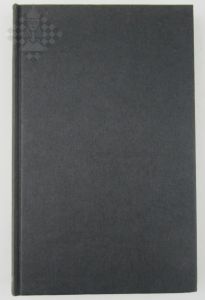 Both Sides of the Chessboard€25.00
Both Sides of the Chessboard€25.00 -
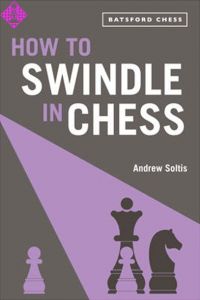 How to Swindle in Chess€17.95
How to Swindle in Chess€17.95 -
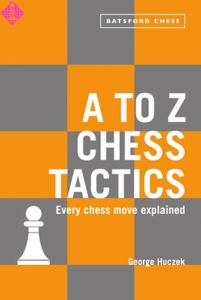 A to Z Chess Tactics€22.95
A to Z Chess Tactics€22.95 - More from Batsford Chess

